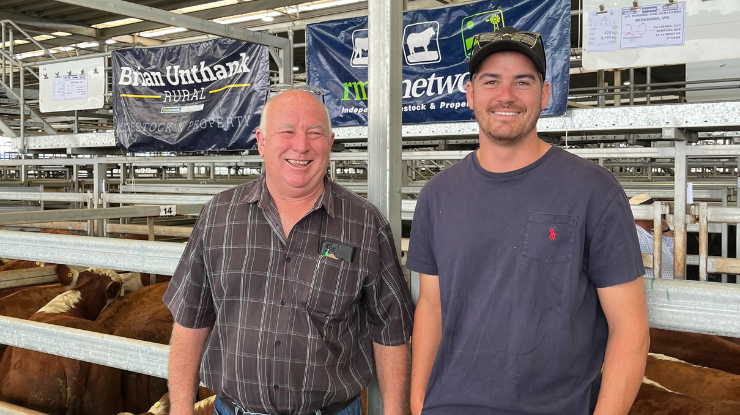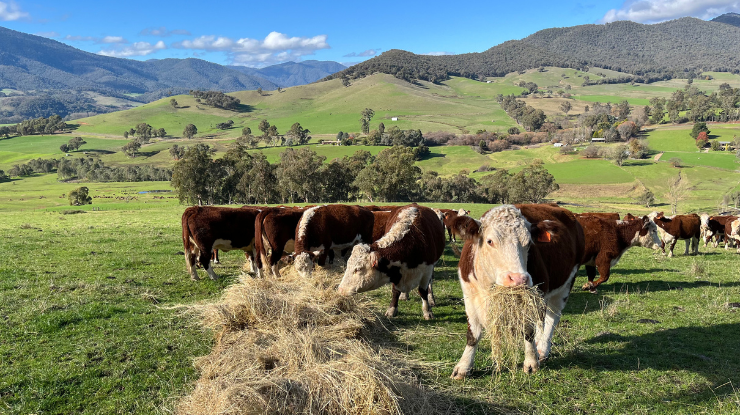 Doug and Charlie Connors with a pen of Running Creek Hereford steers. Image: Charlie Connors
Doug and Charlie Connors with a pen of Running Creek Hereford steers. Image: Charlie Connors
Smarter drenching is no fluke
The Connors family had a proactive approach to managing liver fluke in their beef herd in the high rainfall country near Running Creek, Victoria. Now, equipped with information from an MLA-supported Producer Demonstration Site (PDS), they have their sights set on being fluke-free.
For property manager Charlie Connors, who works alongside his wife and parents, getting involved in the PDS, which focused on optimising liver fluke management in cattle, wasn’t just an opportunity to improve treatment options. It was about staying ahead by keeping informed.
The Connors are cognisant of liver fluke, as they operate in an environment that’s very attractive to the snails that carry the fluke, thanks to the creek running through their property and an average annual rainfall of 1,000mm.
So, when PDS facilitator, University of Melbourne – Mackinnon Project researcher Leah Tyrell offered to test their heifers for free after discussing the disease with them at an industry event – Charlie was keen to learn more.
Prior to participating in the PDS, Charlie said his herd had a slightly lower average weight gain than what they were aiming for.
He credits the PDS with information which, moving forward, should contribute to greater improvements on average weight gains as a result of better managed liver fluke.
“While we’re not yet fluke-free, we are fluke smart, so I think we are on the right track to getting where we want to be.”
Getting informed
Before joining the PDS, the Connors’ approach to liver fluke was similar to that of other participants: a standard annual drench with triclabendazole, plus the occasional follow-up treatment if snail numbers were high.
“We relied visually on snail numbers to determine drench timing,” Charlie said.
“Testing wasn’t part of our routine, but there was nothing to indicate it was necessary – we thought the drench was working.”
When faecal egg count (FEC) testing results showed liver fluke was still present on the property, Charlie jumped at the opportunity to join the Mackinnon Project and the PDS in hopes to refine his fluke management strategies.
Over a two-year demonstration period, he and Leah conducted regular FECs to monitor the impact of different flukicides. One mob of heifers received strategically timed treatments, while a second control group received a treatment when the Connors normally would.
“We found out pretty quickly that the fluke on our property was resistant to triclabendazole,” Charlie said.
“That was a big shock – we were spending money on drench that was not benefiting the health and productivity of our herd.”

The Connors run a self-replacing Hereford herd. Image: Charlie Connors
From routine to strategic
Due to fluke resistance, Charlie had to transition to Nitromec injectable treatment for more effective control.
“It was clear the old drench wasn’t working,” he said.
“Nitromec cleared the fluke properly and gave us a clean slate to maintain.
“It’s not cheap, but the idea is that it will save us money in the longer-term as there will be ability to only use it when FECs tell us it is required.”
Based on the demonstration findings, Charlie also made the decision to shift the timing of his fluke treatments.
“We got the best results treating in May – previously, we drenched in spring when the snails are most active,” he said.
“During the trials, the heifers that were treated in May picked up a lot during the winter and maintained great condition – which is especially great considering the tough winters we’ve had in recent years.
“Overall, I think if we can be strategic about when we drench, we will ensure the best results and a better bang for our buck.”
Looking beyond the fluke
Charlie’s advice to other producers is simple: don’t guess – test.
“You don’t need to test every animal,” he said.
“We are now testing a few – usually the ones who have been in our wetter paddocks.
“We are also testing beyond liver fluke and starting to look at worm egg counts as well to keep us better informed on our herd’s status and needs when it comes to effective disease management.”



